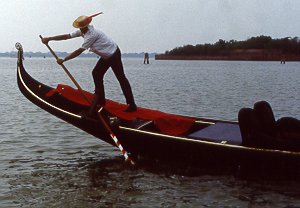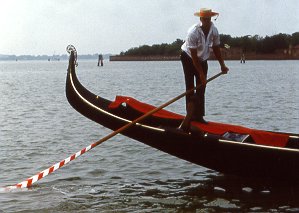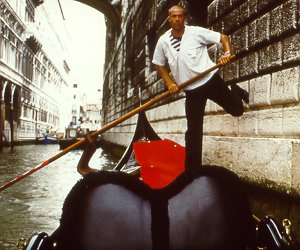ROWING TECHNIQUE
Venetian rowing differs from the usual
style in that the oarsman stands, faces forwards and
rests his oars in special oarlocks - fórcole. It is a pleasant rowing style not only because
it allows you to see where you are going, but because it
is extremely efficient. A recent study confirms that to
transport three people plus the weight of the boat (half
a ton), a gondolier consumes the same amount of energy as
he does walking. Another advantage of this style is the manoeuvrability: the gondolier is able to carry out every
manoeuvre - starting off, right-angle turns, slow or
sudden stops, moving sideways or backwards - without
changing his position.
There are three types of Venetian rowing: first and
foremost the method with a single rower using a single
oar (the oar also acting as rudder), a la valesàna
with a single rower using two crossed oars, and the
method with two or more rowers - normally an even number
- on alternate sides of the boat. In each case, the most
important role is played by the oarsman at the stern.
The use of a single oar - with the resulting lateral
space-saving - is indispensible in the narrow Venetian canals. In fact, when two gondolas arrive from opposite
directions, the oar can be passed under the approaching
boat, or - as the oar is not ‘closed’ in a
oarlock - it can be lifted from the fórcola and aligned
along the length of the hull. It is obvious, though, that
if you row from only one side of the boat it will go
round in circles, so a technique was developed to keep
the boat on a straight course.
The stroke can be divided into two phases: the
‘push’ (premèr ![]() ) during which the oarsman immerses the blade
vertically and pushes on the giròn
) during which the oarsman immerses the blade
vertically and pushes on the giròn ![]() (the shaft of the oar), and the
‘return’ (stalìr
(the shaft of the oar), and the
‘return’ (stalìr ![]() ) in which the oar is moved to its starting
point.
) in which the oar is moved to its starting
point.
|
After the ‘push’ stroke, the gondolier prepares to straighten the boat with the return stroke stalìa. |
While the
‘push’ is fairly intuitive, the
‘return’ is a complex movement in which the oar
is kept underwater and is brought to its starting point
keeping the forward edge of the blade inclined downwards.
This ‘rudder effect’ is used to correct the
direction of the boat.
To prevent water resistance from pushing the oar from its
resting point - as is often the case with beginners - the
grip of the oar is pressed so as to push the oar onto the
fórcola and keep it in place. In this way the morso
![]() (the pivot point for the oar) can be left open
leaving just the nasèlo
(the pivot point for the oar) can be left open
leaving just the nasèlo ![]() (the lower point) curved slightly upwards to
block the oar.
(the lower point) curved slightly upwards to
block the oar.
|
Return stroke, stalìa. Note how the oar, levering on the water with the blade, bends downwards. |
Of course if the
return-stroke were the equivalent of a reverse push-stroke, the boat would point in the right direction
but would remain more or less motionless. Thus every
possible technique is used to reduce the
‘braking’ effect of the return-stroke so as to
gain the maximum forward motion. It is no wonder that
single-oar regattas are considered the
‘university’ of Venetian rowing: they require
strength and stamina, but also technique, style and experience.
As well as the rowing technique, the fact that the boat
leans to the right helps to correct the direction. This
deviation is obtained by moving the load, or the rowers,
to the right, or even - as is the case with the gondola or the puparìn - by
building boats which are ‘bent’. Due to their
asymetric form these boats tend to follow a path to the right.
To give the initial ‘push’ to get the boat in motion, the gondolier uses the base of the fórcola as a
pivot for the oar (rowing sotomòrso), using a
series of rapid side-to-side movements of the oar - which
is kept immersed - so as to keep the boat under control
with the minimum amount of leeway.
|
Start-off or rowing sotomòrso. |
Once the boat is
underway, the oar is placed on the morso for the
normal rowing style already described.
A left turn - andàr premàndo - is simple and
intuitive: it requires a good push on the oar; for a
right turn - andàr stagàndo - the oar is moved
as in the return stroke (stalìa), but with
greater leverage so as to point the bow to the right. To
stop the boat - siàda - the oar is brought onto
the sanca ![]() , with the blade of the oar more or less
vertical depending on the urgency of the manouevre; if
necessary, to avoid a collision, the oar is pulled
frequently and forcefully to create greater water
resistance (the fórcola must be firmly blocked in its
slot, if not it could slip out, the gondolier risking a
backward dive).
, with the blade of the oar more or less
vertical depending on the urgency of the manouevre; if
necessary, to avoid a collision, the oar is pulled
frequently and forcefully to create greater water
resistance (the fórcola must be firmly blocked in its
slot, if not it could slip out, the gondolier risking a
backward dive).
There are two types of stopping manouevre: one where the
boat turns to the right, where the oar is placed on the
lower part of the fórcola for the manouevre siàda
bassa,
|
Stop with a veer to the right - siàda bassa. |
and the other - siàda
alta - which keeps the boat straight or turns it to
the left with the oar placed in the higher part of the
fórcola under the protrusion at the top (récia ![]() ).
).
|
Stop with a veer to the left - siàda alta. |
During the siada,
as with the other manouevres, the orientation of the
blade of the oar should be the same as that for normal rowing, with the angled side pushing the water so as to
keep the wood fibres in the same direction. It is also
advisable to ‘shorten’ the oar (reducing the
length of oar in the water) to avoid a hard backlash on
the arms.
To move backwards, the gondolier places the oar in front
of the fórcola in the sanca, and steps back
rowing with figure-of-eight movements which push the boat
backwards and at the same time correct the direction.
|
Backwards manouevre - indrìo. |
To move the boat sideways, the oar is moved forwards along the side of the boat working as a lever with the hull as pivot. This manouevre - dar zò - is carried out using the right hand only.
|
Lateral manouevre - dar zò - halfway along the boat. |
This technique is also used with the oar near the stern to turn the boat to the right without moving forward as if the boat were on a pivot.
|
Lateral manouevre - dar zò - at the stern. |
To move only the stern to the right, the manouevre tiràr acqua is used: the oar is positioned vertically in the water and is pulled towards the gondolier with both hands, making it oscillate sideways.
|
Moving only the stern to the right - tiràr acqua. |
In narrow canals, the gondolier moves forwards over the rear thwart or trastolìni (the transverse boards which connect the left and right sides of the boat) behind the passenger seats, and rows in sanca, with the oar immersed, alternating left and right diagonal movements as in the voga a bratto.
|
Rowing in narrow canals, on the trastolìni. |
Finally, there is a curious manouevre in which the gondolier uses his feet. It is carried out when the gondola is veered to the right in a very narrow canal and risks knocking the stern against the walls. In this case the gondolier stretches his left leg over the side of the boat and pushes against the wall to avoid contact.
|
Using the left foot to veer right. |










